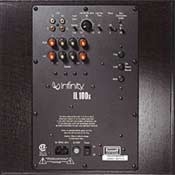Subway Series Page 2
All eight subs have line-level inputs, output-level controls, a phase switch, a variable-frequency electronic crossover, and an internal power amplifier. All but the M&K MX-125 Mk II have speaker-level inputs, some have both line- and speaker-level outputs, and all but the Polks have a crossover bypass (for use with a receiver's bass-management facilities). All except the M&K pair and the Polk PSW250, which must be manually switched on and off, have an auto-power feature that turns them on or off depending on whether an input signal is present. The M&K MX-125 Mk II and Polk PSW650 are the only models without magnetic shielding. (See "Fast Facts" below for more on each sub's specifications and features.) While every sub here has everything necessary to fit in with almost any home theater system, some have additional features that can help make the job easier.
Infinity Interlude IL 100s and Intermezzo 1.2s
 You could never mistake these two Infinity subwoofers -- designed for the Interlude and Intermezzo home theater speaker systems, respectively -- for your usual black cube with a square black grille. With their graceful shapes and striking design touches, both display the kind of styling you usually associate with expensive foreign cars. The elegant curves of the Intermezzo's platinum-finish cast-aluminum cabinet are especially striking. Even though they're about the same size, the Intermezzo sub is nearly twice as heavy as the Interlude, with the additional weight attributable to its cabinet and 850-watt amplifier.
You could never mistake these two Infinity subwoofers -- designed for the Interlude and Intermezzo home theater speaker systems, respectively -- for your usual black cube with a square black grille. With their graceful shapes and striking design touches, both display the kind of styling you usually associate with expensive foreign cars. The elegant curves of the Intermezzo's platinum-finish cast-aluminum cabinet are especially striking. Even though they're about the same size, the Intermezzo sub is nearly twice as heavy as the Interlude, with the additional weight attributable to its cabinet and 850-watt amplifier.
The Interlude and Intermezzo subs have complete feature sets and some nice extras, including 15-foot power cords that give you a lot of placement flexibility. Both have front-panel level controls in addition to the usual rearward controls. At first glance, the front-mounted control seems to be a plus -- it could be handy for making occasional level adjustments once you have the sub in place -- but setup is easier when all of the controls are in one place.
Both models also have a one-band parametric equalizer, which you can use with Infinity's unique Room Adaptive Bass Optimization System (R.A.B.O.S.) to help find the best position for the sub and equalize its room response. The R.A.B.O.S. test and measurement kit, which includes instructions, a test CD, and a sound-level meter, comes standard with the Intermezzo; it's a $60 option with the Interlude. You place the sub where you expect to put it, play the CD through the sub, use the sound meter to measure the frequency response at your listening position, and then plot the results on the supplied chart. The result is a nice graph of the sub's response in your room. You then use the supplied template and response-curve "slide rule" to determine the optimum settings for the equalizer. The object, of course, is to make the bass sound as smooth as possible, neither boomy nor weak in any part of the sub's range. (The kit, available separately, will help anyone determine exactly what kind of effect the room has on a subwoofer's performance.)
Unlike many subs I've tested, both models have crossover markings that sync pretty well with the actual crossover frequencies. The Intermezzo's line-level outputs include a 100-Hz, 6-dB-per-octave high-pass filter that's not mentioned in the manual, and the rear control panel sports a pushbutton labeled High-Level High-Pass that's pictured in the manual but not mentioned or specified. Guess what: it turns on a 100-Hz, 6-dB-per-octave high-pass filter for the speaker-level outputs.
In the lab, both models pumped out the kind of deep bass to qualify them as true subwoofers (rather than "bass modules" that cut off at about 40 Hz), but the Intermezzo played louder and lower. The Interlude's 10-inch driver and 250-watt amp produced 79 dB sound-pressure level (SPL) at 20 Hz with low distortion, while the Intermezzo, with its 12-inch driver and 850-watt amp, managed 90 dB at 20 Hz and a stout 80-dB rumble way down at 16 Hz.








































